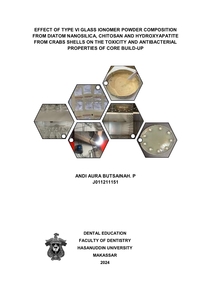P, ANDI AURA BUTSAINAH. (2024) EFFECT OF TYPE VI GLASS IONOMER POWDER COMPOSITION FROM DIATOM NANOSILICA, CHITOSAN AND HYDROXYAPATITE FROM CRABS SHELLS ON THE TOXICITY AND ANTIBACTERIAL PROPERTIES OF CORE BUILD-UP=EFFECT OF TYPE VI GLASS IONOMER POWDER COMPOSITION FROM DIATOM NANOSILICA, CHITOSAN AND HYDROXYAPATITE FROM CRABS SHELLS ON THE TOXICITY AND ANTIBACTERIAL PROPERTIES OF CORE BUILD-UP. Skripsi thesis, UNIVERSITAS HASANUDDIN.
![[thumbnail of cover]](/46943/1.hassmallThumbnailVersion/J011211151_skripsi_29-11-2024%20COVER1.jpg)

J011211151_skripsi_29-11-2024 COVER1.jpg
Download (278kB) | Preview
J011211151_skripsi_29-11-2024 BAB 1-2.pdf
Download (697kB)
J011211151_skripsi_29-11-2024 DP.pdf
Download (926kB)
J011211151_skripsi_29-11-2024.pdf
Restricted to Repository staff only until 18 November 2027.
Download (1MB)
Abstract (Abstrak)
Background: Core build-ups are restorations placed on severely damaged teeth. One attempt to improve the mechanical properties of GIC core build-ups is to replace the silica content using natural nanosilica from diatoms and additives such as hydroxyapatite and chitosan which can be obtained from mud crab (Scylla serrata) shells. Assessment of core build-up restoration materials should also include their biocompatibility and antibacterial properties. Measurements include cytotoxicity, one of the initial methods for toxicity testing is the Brine Shrimp Lethality Test (BSLT) using Artemia salina. In addition, the preferred restoration materials are those that can prevent bacterial growth and surface colonization. To prove the antibacterial effect of GIC core build-up against Streptococcus mutans bacteria, it is necessary to conduct an antibacterial test. Research Objective: to determine the effect of Glass Ionomer Type VI powder composition of diatomaceous nanosilica as well as chitosan and hydroxyapatite from crab shells on the toxicity and antibacterial effect of core build-up. Research Methods: The research used is Experimental Laboratories research. Results: The formation of inhibition zones around the wells in each group of modified GIC formulations and the death of Artemia salina Leach at each toxicity test concentration. Conclusion: From the results of the modified GIC antibacterial test of the F1-F8 group, it is known that the highest inhibition is in the F8 group with an average inhibition zone of 13.77 mm and is classified as strong in inhibiting Streptococcus mutans bacteria. The results of toxicity testing using the BLST method on GIC group F8 against Artemia salina Leach are known to be non-toxic and obtained an LC50 value of 2219.051 ppm.
| Item Type: | Thesis (Skripsi) |
|---|---|
| Uncontrolled Keywords: | Diatom nanosilica, hydroxyapatite, chitosan, Anti-bacterial, toxicity, Streptococcus mutans, Artemia salina Leach, Glass Ionomer Cement |
| Subjects: | R Medicine > RK Dentistry |
| Divisions (Program Studi): | Fakultas Pendidikan Dokter Gigi > Pendidikan Dokter Gigi |
| Depositing User: | Unnamed user with username pkl2 |
| Date Deposited: | 14 Jul 2025 06:00 |
| Last Modified: | 14 Jul 2025 06:00 |
| URI: | http://repository.unhas.ac.id:443/id/eprint/46943 |


